
The Crassulaceae, also known as the stonecrop family or the orpine family, are a diverse family of dicotyledon flowering plants characterized by succulent leaves and a unique form of photosynthesis, known as Crassulacean acid metabolism (CAM). Flowers generally have five floral parts. Crassulaceae are usually herbaceous but there are some subshrubs, and relatively few treelike or aquatic plants. Crassulaceae are a medium-sized monophyletic family in the core eudicots, among the order Saxifragales, whose diversity has made infrafamilial classification very difficult. The family includes approximately 1,400 species and 34–35 genera, depending on the circumscription of the genus Sedum, and distributed over three subfamilies. Members of the Crassulaceae are found worldwide, but mostly in the Northern Hemisphere and southern Africa, typically in dry and/or cold areas where water may be scarce, although a few are aquatic.

Sempervivum is a genus of about 40 species of flowering plants in the family Crassulaceae, commonly known as houseleeks. Other common names include liveforever and hen and chicks, a name shared with plants of other genera as well. They are succulent perennials forming mats composed of tufted leaves in rosettes. In favourable conditions they spread rapidly via offsets, and several species are valued in cultivation as groundcover for dry, sunny locations.

Aichryson is a genus of about 15 species of succulent, subtropical plants, mostly native to the Canary Islands, with a few in the Azores, Madeira and Morocco.

Jovibarba is a small genus of three species of succulent flowering plants in the family Crassulaceae, endemic to mountainous regions in the southeastern quadrant of Europe. The genus is sometimes classified as a subgenus of Sempervivum, to which it is closely related. Jovibarba have pale-greenish-yellow or yellow actinomorphic flowers with about six petals, while Sempervivum have generally pinkish flowers with around twice as many petals, which open more widely than jovibarba flowers. The common name hen and chicks is applied to some Jovibarba species.

A plant cutting is a piece of a plant that is used in horticulture for vegetative (asexual) propagation. A piece of the stem or root of the source plant is placed in a suitable medium such as moist soil. If the conditions are suitable, the plant piece will begin to grow as a new plant independent of the parent, a process known as striking. A stem cutting produces new roots, and a root cutting produces new stems. Some plants can be grown from leaf pieces, called leaf cuttings, which produce both stems and roots. The scions used in grafting are also called cuttings.

Sedum morganianum, the donkey tail or burro's tail, is a species of flowering plant in the family Crassulaceae, native to southern Mexico. It is a succulent perennial producing trailing stems up to 60 cm (24 in) long, with fleshy blue-green leaves and terminal pink to red flowers in summer. S. morganianum has been found wild in two ravines at Tenampa county, in central Veracruz, in eastern Mexico and on vertical cliffs of igneous rock in the Tropical Deciduous Forest zone. Due to its restricted geographic distribution, it should be regarded as a micro-endemic species.

Sempervivum tectorum, the common houseleek, is a species of flowering plant in the family Crassulaceae, native to the mountains of southern Europe, cultivated in the whole of Europe for its appearance and a Roman tradition claiming that it protects buildings against lightning strikes.
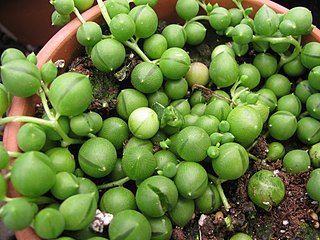
Curio rowleyanus, syn. Senecio rowleyanus, is a flowering plant in the daisy family Asteraceae. It is a creeping, perennial, succulent vine native to the Cape Provinces of South Africa. In its natural environment its stems trail on the ground, rooting where they touch and form dense mats. It often avoids direct sunlight by growing in the shade of other plants and rocks. It is commonly known as string-of-pearls or string-of-beads.
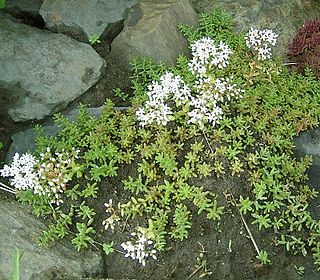
Sedum album, the white stonecrop, is a flowering plant of the genus Sedum in the family Crassulaceae. It is found in the northern temperate regions of the world, often growing in crevices or free-draining rocky soil. As a long-day plant it grows vegetatively for most of the year and flowers in summer.

Sedum rubrotinctum or Sedum × rubrotinctum, commonly known as jelly-beans, jelly bean plant, or pork and beans, is a species of Sedum from the plant family Crassulaceae. It is a succulent plant originating in Mexico. The common English name refers to its short leaves that resemble jelly beans, especially when taking on a protective hue.

In botany, succulent plants, also known as succulents, are plants with parts that are thickened, fleshy, and engorged, usually to retain water in arid climates or soil conditions. The word succulent comes from the Latin word sucus, meaning "juice" or "sap".

Sempervivium calcareum, the houseleek, is a species of flowering plant in the stonecrop family Crassulaceae, native to the southern Alps in Europe. An evergreen succulent perennial, it has a rosette with thick leaves that store water. The leaves are usually green with reddish-purple tips. This plant reproduces with asexual budding and monocarpic sexual reproduction.

Sedum dendroideum, commonly known as the tree stonecrop or the false hens-and-chickens, is a shrub-like perennial plant that looks much like its Sempervivum look-alike. Native to Mexico,
Sempervivum altum is a species of flowering plant in the family Crassulaceae, native to the Caucasus Mountains. Like other members of the houseleek genus, it grows succulent leaves in rosettes. The rosettes of S. altum are 1–5 cm across, and the leaves are pubescent or pilose. The flowers are pink edged with white, with yellow anthers, growing on a stem 30–40 cm tall. The species was described in 1936 by William Bertram Turrill based on specimens collected by P.L. Giuseppi in a 1935 expedition to the Caucasus Mountains. It is closely related to S. ingwersenii and S. ossetiense from the same region. As of June 2013, the name is not accepted by the World Checklist of Selected Plant Families.
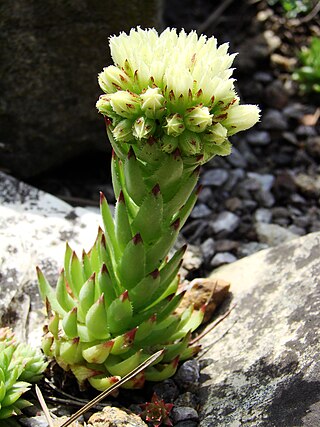
Jovibarba globifera, common name rolling hen-and-chicks, is a species of succulent flowering plant in the family Crassulaceae.
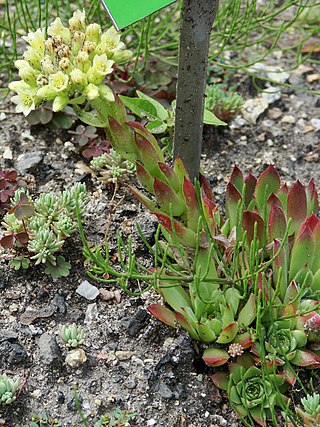
Jovibarba heuffelii, common name hen-and-chickens, as a plant species native to the Balkans and to the Carpathians in Europe but reportedly naturalized in Wisconsin and probably in other parts of North America. It grows on rocky outcrops.

Sedum adolphi, the coppertone stonecrop or golden Sedum, is a species of succulent plant in the family Crassulaceae. It is native to Mexico, where it grows in rocky terrain and on cliff faces. It has also become naturalized in Sicily and the Canary Islands. It is known for its bright orange-copper leaves and white flowers that bloom in the spring.

Hen and chicken is a common name for several unrelated groups of plants. The name refers to the tendency of certain of these species to reproduce vegetatively by means of plantlets. These tiny plants are produced by the mother plant, and take root on touching the ground.
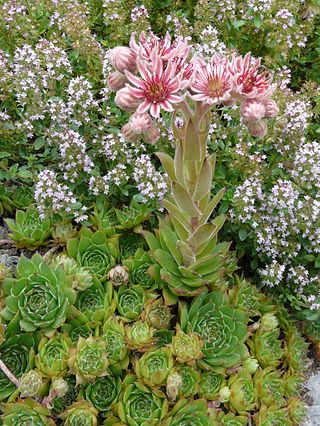
Sempervivum marmoreum is a flowering plant in the family Crassulaceae. It is a succulent native to south-eastern Europe and central Europe. Sempervivum marmoreum naturally grows on rocky outcrops with southern exposure.

Sempervivum ciliosum, the Teneriffe houseleek is a species of flowering plant in the succulent stonecrop family, Crassulaceae, native to the Balkans and Southeastern Europe. Despite a superficial resemblance, houseleeks are not closely related to the American cacti family. A colony-forming evergreen perennial plant, each individual rosette can grow to around 7.5 cm (3.0 in) high and wide, forming dense mats of up to 50 cm (20 in) wide.

























